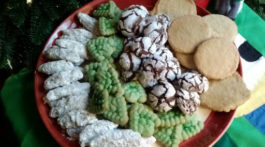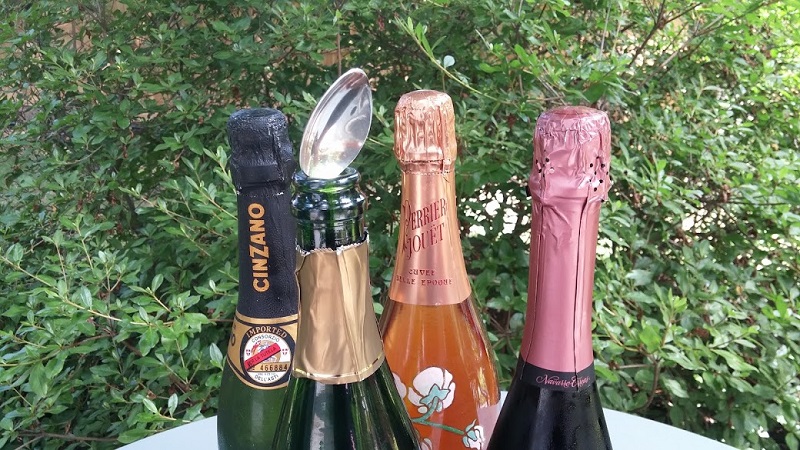A spoon was sticking out of the open sparkling wine bottle – handle down the neck, bowl resting on the rim. I tried to imagine a random act that would end this way – an open bottle in the refrigerator door and a spoon accidentally flipped with such random accuracy that it’s handle ended up down the bottle. I also wondered why no one but me noticed or at least commented.
“No accident,” said my niece. “The spoon is in the bottle to keep the wine from going flat.” I found this remarkable but didn’t think much more about it. A few weeks later my niece organized a gathering of neighbors to practice speaking french. Afterwards, I found another bottle with a spoon in the neck. One of the participants, fearing linguistic shyness, had brought a bottle of good french champagne to loosen tongues. The bottle went unfinished (it was a morning session) so the spoon was keeping the wine bubbly.
With more time to think about it, my skepticism had time to develop. I couldn’t imagine how this could work. Fortunately, the internet was there to answer questions like this with a simple Google search. Pages of information popped up, links to sites where this was discussed at length, about 627,000 results according to the note at the top. Apparently it’s a question that has come up before.
Champagne bubbles come from carbon dioxide dissolved in the wine during the winemaking process. When this happens in a closed container, like a champagne bottle, the CO2 merges into the wine. When the pressure is released by opening the bottle, the CO2 emerges in the form of bubbles. In large scale production, this can be done less expensively in a tank instead of the bottle. Sometimes in mass market wines, carbon dioxide is injected into the wine, just like in Coke.
There is considerable disagreement on how effective the spoon is. Some say it keeps the bubbles intact, while others say it’s a myth. Most of the studies that explore this question involve opening a bunch of champagne bottles, drinking some, storing the rest open and closed, with a spoon and without. Then a day or two later, drinking some more. Notice that there’s a lot of drinking going on in these experiments.
Although this seems like a lot of fun and easy to do at home, it’s likely that the results may be impacted by a party atmosphere. After all, with plenty of wine and maybe some hors d’oeuvre to keep the pallets clear, how scientific can the tasting be? A quick glance over some of the experiments described online seems to support me on this. The more fun that is had, the more effective the spoon is likely to be.
A few more rigorous studies have been conducted, including one by Professor Richard Zare from Stanford University, Harold McGee (who is an authority on the physics and chemistry of cooking), and a bunch of their high-level academic pals. Although the method was dependent on tasting, I have to think that their scientific background brought a little more credibility to the experiment.
They did not find the spoon to be the most effective way to keep the bubbles in. Surprisingly, the most fizzy bottle in their study was one left open with nothing to help retain the bubbles. Re-corking was not the most successful strategy either.
The experimenters on Myth Busters – a reality show that applies the scientific method to everyday questions – had much the same results (See it on Youtube). For them, the one with the spoon had the least fizz; the re-corked bottle had the most; and a bottle that had not been opened at all came in second. The bottle stored open came in third.
Although these results are inconsistent, a few conclusions can be drawn. It looks like the spoon idea falls flat. It seems like an open bottle can be best, which doesn’t make any sense at all.
The experimenters don’t reveal what wine’s they’re using, but that has to have some impact on the results. Good sparkling wine, made with the méthode Champenoise is famous for its tiny bubbles and vibrant sparkle. I have to think that a quality wine like this will keep its bubbles longer than a wine made by a more industrial process. Excellence will prevail.
I also think that the lower the level in the bottle the quicker the loss of sparkle. Sparkling wine bottles get wider towards the bottom and this greater surface area plus more air in the bottle has to translate into faster flattening. The studies were all about bubbles, not taste. Any wine open to the air will lose freshness and flavor, eventually getting oxidized.
Most testers agreed that keeping the wine cold is essential and very effective. A good chill helps the carbon dioxide stay dissolved in the wine.
The only sure fire way I know to keep maximum sparkle in your wine is to drink it all within a few hours of opening the bottle. You’ll save space in the refrigerator too.
If you would like to conduct your own experiment, please let me know the results. Even better, I’d be happy to serve on your taste panel.











No Comment